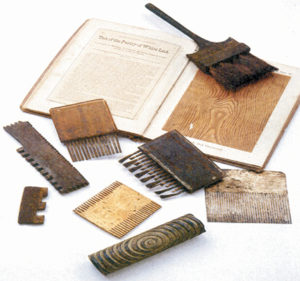
Mona of Loveland, Colorado, writes, “These are tools for making fake grain on wood. I lived in an 1880’s mansion and all the original doors and baseboards (10”) had been “grained” with stains. It was real wood, so I never understood why the grain was added. Style and design?” Mona is correct. One of 19th Century guides for decorating furniture is “The American Grainers’ Hand-book” which contained details on pigments. Tools that were reommended included a horsehair brush, a blender brush, combs made of ivory, steel and wood, and a grooved rubber cylinder for imitating burl grain. This technique was popular in the 1800s during the heyday of imitative painting.
One of our contest guessers Cheryl Miller said that she also used similar tools to marble paper and bookend papers. Another contest winner Sam Taylor described the tools as a softening brush, roller rocker, graining brushes and graining tools. He said they were used to create a faux wood grain look using paint or glaze. Congratulations to our winners. They include: Cheryl Miller, Ft. Collins, Colorado; Sam Taylor, Glenwood Springs, Colorado; and, Teresa Cobb, Cawker City, Kansas. You have won a year’s subscription to the Mountain States Collector. Thank you for entering our contest.















Follow Us